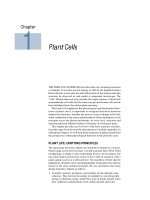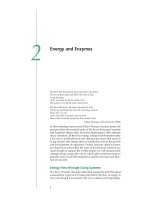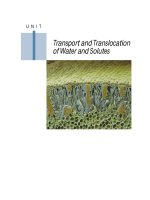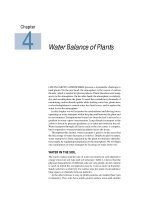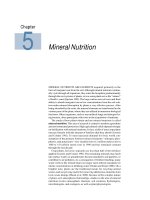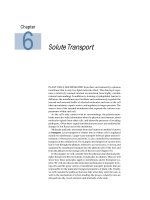2018 cardiovascular physiology
Bạn đang xem bản rút gọn của tài liệu. Xem và tải ngay bản đầy đủ của tài liệu tại đây (9.75 MB, 398 trang )
Copyright © 2018 by McGraw-Hill Education. All rights reserved. Except
as permitted under the United States Copyright Act of 1976, no part of this
publication may be reproduced or distributed in any form or by any means,
or stored in a database or retrieval system, without the prior written
permission of the publisher.
ISBN: 978-1-26-002612-2
MHID:
1-26-002612-4
The material in this eBook also appears in the print version of this title:
ISBN: 978-1-26-002611-5, MHID: 1-26-002611-6.
eBook conversion by codeMantra
Version 1.0
All trademarks are trademarks of their respective owners. Rather than put a
trademark symbol after every occurrence of a trademarked name, we use
names in an editorial fashion only, and to the benefit of the trademark
owner, with no intention of infringement of the trademark. Where such
designations appear in this book, they have been printed with initial caps.
McGraw-Hill Education eBooks are available at special quantity discounts
to use as premiums and sales promotions or for use in corporate training
programs. To contact a representative, please visit the Contact Us page at
www.mhprofessional.com.
TERMS OF USE
This is a copyrighted work and McGraw-Hill Education and its licensors
reserve all rights in and to the work. Use of this work is subject to these
terms. Except as permitted under the Copyright Act of 1976 and the right
to store and retrieve one copy of the work, you may not decompile,
disassemble, reverse engineer, reproduce, modify, create derivative works
based upon, transmit, distribute, disseminate, sell, publish or sublicense the
work or any part of it without McGraw-Hill Education’s prior consent.
You may use the work for your own noncommercial and personal use; any
other use of the work is strictly prohibited. Your right to use the work may
be terminated if you fail to comply with these terms.
THE WORK IS PROVIDED “AS IS.” McGRAW-HILL EDUCATION
AND ITS LICENSORS MAKE NO GUARANTEES OR WARRANTIES
AS TO THE ACCURACY, ADEQUACY OR COMPLETENESS OF OR
RESULTS TO BE OBTAINED FROM USING THE WORK,
INCLUDING ANY INFORMATION THAT CAN BE ACCESSED
THROUGH THE WORK VIA HYPERLINK OR OTHERWISE, AND
EXPRESSLY DISCLAIM ANY WARRANTY, EXPRESS OR IMPLIED,
INCLUDING BUT NOT LIMITED TO IMPLIED WARRANTIES OF
MERCHANTABILITY OR FITNESS FOR A PARTICULAR PURPOSE.
McGraw-Hill Education and its licensors do not warrant or guarantee that
the functions contained in the work will meet your requirements or that its
operation will be uninterrupted or error free. Neither McGraw-Hill
Education nor its licensors shall be liable to you or anyone else for any
inaccuracy, error or omission, regardless of cause, in the work or for any
damages resulting therefrom. McGraw-Hill Education has no
responsibility for the content of any information accessed through the
work. Under no circumstances shall McGraw-Hill Education and/or its
licensors be liable for any indirect, incidental, special, punitive,
consequential or similar damages that result from the use of or inability to
use the work, even if any of them has been advised of the possibility of
such damages. This limitation of liability shall apply to any claim or cause
whatsoever whether such claim or cause arises in contract, tort or
otherwise.
Contents
Preface
Chapter 1 Overview of the Cardiovascular System
Objectives
Evolution and Homeostatic Role of the Cardiovascular System
Overall Design of the Cardiovascular System
The Basic Physics of Blood Flow
Material Transport by Blood Flow
The Heart
The Vasculature
Blood
Perspectives
Chapter 2 Characteristics of Cardiac Muscle Cells
Objectives
Electrical Activity of Cardiac Muscle Cells
Mechanical Activity of the Heart
Relating Cardiac Muscle Cell Mechanics to Ventricular Function
Perspectives
Chapter 3 The Heart Pump
Objectives
Cardiac Cycle
Determinants of Cardiac Output
Influences on Stroke Volume
Summary of Determinants of Cardiac Output
Summary of Sympathetic Neural Influences on Cardiac Function
Cardiac Energetics
Perspectives
Chapter 4 Measurements of Cardiac Function
Objectives
Measurement of Mechanical Function
Measurement of Cardiac Excitation—The Electrocardiogram
Perspectives
Chapter 5 Cardiac Abnormalities
Objectives
Electrical Abnormalities and Arrhythmias
Cardiac Valve Abnormalities
Perspectives
Chapter 6 The Peripheral Vascular System
Objectives
Transcapillary Transport
Resistance and Flow in Networks of Vessels
Normal Conditions in the Peripheral Vasculature
Measurement of Arterial Pressure
Determinants of Arterial Pressure
Perspectives
Chapter 7 Vascular Control
Objectives
Vascular Smooth Muscle
Control of Arteriolar Tone
Control of Venous Tone
Summary of Primary Vascular Control Mechanisms
Vascular Control in Specific Organs
Perspectives
Chapter 8 Hemodynamic Interactions
Objectives
Key System Components
Central Venous Pressure: An Indicator of Circulatory Status
Perspectives
Chapter 9 Regulation of Arterial Pressure
Objectives
Short-Term Regulation of Arterial Pressure
Long-Term Regulation of Arterial Pressure
Perspectives
Chapter 10 Cardiovascular Responses to Physiological Stresses
Objectives
Primary Disturbances and Compensatory Responses
Effect of Respiratory Activity
Effect of Gravity
Effect of Exercise
Normal Cardiovascular Adaptations
Perspectives
Chapter 11 Cardiovascular Function in Pathological Situations
Objectives
Circulatory Shock
Cardiac Disturbances
Hypertension
Perspectives
Answers to Study Questions
Appendix A
Appendix B
Appendix C
Appendix D
Appendix E
Index
Preface
In this our final edition as primary authors of this text, we have continued
our penchant of focusing on the big picture of how and why the
cardiovascular system operates as it does. Our firm belief is that to
evaluate the importance and consequences of specific details it is essential
to appreciate where they fit in the big picture. The core idea is for students
not to get lost in the forest for the trees. The same approach will serve
practitioners well throughout their careers as they evaluate new
information as it arises.
The cardiovascular system is a circular interconnection of many
individual components—each with its own rules of operation that must be
followed. But in the intact system, the individual components are forced to
interact with each other. A change in the operation of any one component
has repercussions throughout the system. Understanding such interactions
is essential to developing a big picture of how the intact system behaves.
Only then can one fully understand all the consequences of malfunctions
in particular components and/or particular clinical interventions.
This ninth edition includes some recent, new findings as well as a
newly added emphasis on cardiovascular energetics. The latter is a result
of our recent realization that maximizing energy efficiency to limit the
workload on the heart is an important part of the overall plan.
As always, we express sincere thanks to our families for their continual
support of our efforts, and to our mentors, colleagues, and students for all
they have taught us over the years. Also, these authors would like to thank
each other for the uncountable but fruitful hours we have spent arguing
about how the cardiovascular system operates from our own (and often
very different perspectives).
David E. Mohrman, PhD
Lois Jane Heller, PhD
Overview of the Cardiovascular
System
1
OBJECTIVES
The student understands the homeostatic role of the cardiovascular
system, the basic principles of cardiovascular transport, and the
basic structure and function of the components of the system:
Defines homeostasis.
Identifies the major body fluid compartments and states the
approximate volume of each.
Lists 3 conditions, provided by the cardiovascular system, that
are essential for regulating the composition of interstitial fluid
(i.e., the internal environment).
Predicts the relative changes in flow through a tube caused by
changes in tube length, tube radius, fluid viscosity, and pressure
difference.
Uses the Fick principle to describe convective transport of
substances through the CV system and to calculate a tissue’s rate
of utilization (or production) of a substance.
Identifies the chambers and valves of the heart and describes the
pathway of blood flow through the heart.
Defines cardiac output and identifies its 2 determinants.
Describes the site of initiation and pathway of action potential
propagation in the heart.
States the relationship between ventricular filling and cardiac
output (the Starling law of the heart) and describes its importance
in the control of cardiac output.
Identifies the distribution of sympathetic and parasympathetic
nerves in the heart and lists the basic effects of these nerves on the
heart.
Lists the 5 factors essential to proper ventricular pumping action.
Lists the major different types of vessels in a vascular bed and
describes the morphological differences among them.
Describes the basics and functions of the different vessel types.
Identifies the major mechanisms in vascular resistance control
and blood flow distribution.
Describes the basic composition of the fluid and cellular portions
of blood.
EVOLUTION AND HOMEOSTATIC ROLE OF
THE CARDIOVASCULAR SYSTEM
All living organisms require outside energy sources to survive. Indeed,
Darwin deduced his evolutionary concepts largely on observations of
external adaptations that evolved in different organisms to exploit
particular unique sources of “food” energy. Clearly one strong
evolutionary force has been to maximize the ability to obtain outside
energy.
In the big picture of “survival of the fittest,” equally important to
obtaining outside energy is making efficient use of it once it is obtained.
Therefore, we contend that developing energy-efficient mechanisms to
accomplish all internal tasks necessary for successful life has also been a
strong evolutionary force and probably applies to all “internal” processes.
In this text, we focus on how the design and operation of the human
cardiovascular system has evolved to accomplish its essential tasks with a
minimum of energy expenditure.
A 19th-century French physiologist, Claude Bernard (1813–1878),
first recognized that all higher organisms actively and constantly strive to
prevent the external environment from upsetting the conditions necessary
for life within the organism. Thus, the temperature, oxygen concentration,
pH, ionic composition, osmolarity, and many other important variables of
our internal environment are closely controlled. This process of
maintaining the “constancy” of our internal environment has come to be
known as homeostasis. To aid in this task, an elaborate material transport
network, the cardiovascular system, has evolved.
Three compartments of watery fluids, known collectively as the total
body water, account for approximately 60% of body weight in a normal
adult. This water is distributed among the intracellular, interstitial, and
plasma compartments, as indicated in Figure 1–1. Note that about twothirds of our body water is contained within cells and communicates with
the interstitial fluid across the plasma membranes of cells. Of the fluid that
is outside cells (i.e., extracellular fluid), only a small amount, the plasma
volume, circulates within the cardiovascular system. Total circulating
blood volume is larger than that of blood plasma, as indicated in Figure 1–
1, because blood also contains suspended blood cells that collectively
occupy approximately 40% of its volume. However, it is the circulating
plasma that directly interacts with the interstitial fluid of body organs
across the walls of the capillary vessels.
The interstitial fluid is the immediate environment of individual cells.
(It is the “internal environment” referred to by Bernard.) These cells must
draw their nutrients from and release their products into the interstitial
fluid. The interstitial fluid cannot, however, be considered a large reservoir
for nutrients or a large sink for metabolic products, because its volume is
less than half that of the cells that it serves. The well-being of individual
cells therefore depends heavily on the homeostatic mechanisms that
regulate the composition of the interstitial fluid. This task is accomplished
by continuously exposing the interstitial fluid to “fresh” circulating plasma
fluid.
Figure 1–1. Major body fluid compartments with average volumes indicated for a normal 70-kg
adult human. Total body water is approximately 60% of body weight.
As blood passes through capillaries, solutes exchange between plasma
and interstitial fluid by the process of diffusion. The net result of
transcapillary diffusion is always that the interstitial fluid tends to take on
the composition of the incoming blood. If, for example, potassium ion
concentration in the interstitium of a particular skeletal muscle was higher
than that in the plasma entering the muscle, then potassium would diffuse
into the blood as it passes through the muscle’s capillaries. Because this
removes potassium from the interstitial fluid, its potassium ion
concentration would decrease. It would stop decreasing when the net
movement of potassium into capillaries no longer occurs, that is, when the
concentration of the interstitial fluid reaches that of incoming plasma.
Three conditions are essential for this circulatory mechanism to
effectively control the composition of the interstitial fluid: (1) there must
be adequate blood flow through the tissue capillaries; (2) the chemical
composition of the incoming (or arterial) blood must be controlled to be
that which is optimal in the interstitial fluid; and (3) diffusion distances
between plasma and tissue cells must be short. Figure 1–1 shows how the
cardiovascular transport system operates to accomplish these tasks.
Diffusional transport within tissues occurs over extremely small distances
because no cell in the body is located farther than approximately 10 μm
from a capillary. Over such microscopic distances, diffusion is a very rapid
process that can move huge quantities of material. Diffusion, however, is a
very poor mechanism for moving substances from the capillaries of an
organ, such as the lungs, to the capillaries of another organ that may be 1
m or more distant. Consequently, substances are transported between
organs by the process of convection, by which the substances easily move
along with blood flow because they are either dissolved or contained
within blood. The relative distances involved in cardiovascular transport
are not well illustrated in Figure 1–1. If the figure was drawn to scale, with
1 inch representing the distance from capillaries to cells within a calf
muscle, then the capillaries in the lungs would have to be located about 15
miles away!
OVERALL DESIGN OF THE
CARDIOVASCULAR SYSTEM
The overall functional arrangement of the cardiovascular system is
illustrated in Figure 1–2. Because a functional rather than an anatomical
viewpoint is expressed in this figure, the role of heart appears in 3 places:
as the right heart pump, as the left heart pump, and as the heart muscle
tissue. It is common practice to view the cardiovascular system as (1) the
pulmonary circulation, composed of the right heart pump and the lungs,
and (2) the systemic circulation, in which the left heart pump supplies
blood to the systemic organs (all structures except the gas exchange
portion of the lungs). The pulmonary and systemic circulations are
arranged in series, that is, one after the other. Consequently, both the right
and left hearts must pump an identical volume of blood per minute. This
amount is called the cardiac output.
As indicated in Figure 1–2, most systemic organs are functionally
arranged in parallel (i.e., side by side) within the cardiovascular system.
There are 2 important consequences of this parallel arrangement. First,
nearly all systemic organs receive blood of identical composition—that
which has just left the lungs and is known as arterial blood. Second, the
flow through any one of the systemic organs can be controlled
independently of the flow through the other organs. Thus, for example, the
cardiovascular response to whole-body exercise can involve increased
blood flow through some organs, decreased blood flow through others, and
unchanged blood flow through yet others.
Many of the organs in the body help perform the task of continually
reconditioning the blood circulating in the cardiovascular system. Key
roles are played by organs, such as the lungs, that communicate with the
external environment. As is evident from the arrangement shown in Figure
1–2, any blood that has just passed through a systemic organ returns to the
right heart and is pumped through the lungs, where oxygen and carbon
dioxide are exchanged. Thus, the blood’s gas composition is always
reconditioned immediately after leaving a systemic organ.
Figure 1–2. Cardiovascular circuitry, indicating the percentage distribution of cardiac output to
various organ systems in a resting individual.
Like the lungs, many of the systemic organs also serve to recondition
the composition of blood, although the flow circuitry precludes their doing
so each time the blood completes a single circuit. The kidneys, for
example, continually adjust the electrolyte composition of the blood
passing through them. Because the blood conditioned by the kidneys
mixes freely with all the circulating blood and because electrolytes and
water freely pass through most capillary walls, the kidneys control the
electrolyte balance of the entire internal environment. To achieve this, it is
necessary that a given unit of blood pass often through the kidneys. In fact,
the kidneys normally receive about one-fifth of the cardiac output under
resting conditions. This greatly exceeds the amount of flow that is
necessary to supply the nutrient needs of the renal tissue. This situation is
common to organs that have a blood-conditioning function.
Blood-conditioning organs can also withstand, at least temporarily,
severe reduction of blood flow. Skin, for example, can easily tolerate a
large reduction in blood flow when it is necessary to conserve body heat.
Most of the large abdominal organs also fall into this category. The reason
is simply that because of their blood-conditioning functions, their normal
blood flow is far in excess of that necessary to maintain their basal
metabolic needs.
The brain, heart muscle, and skeletal muscles typify organs in which
blood flows solely to supply the metabolic needs of the tissue. They do not
recondition the blood for the benefit of any other organ. Normally, the
blood flow to the brain and the heart muscle is only slightly greater than
that required for their metabolism; hence, they do not tolerate blood flow
interruptions well. Unconsciousness can occur within a few seconds after
stoppage of cerebral flow, and permanent brain damage can occur in as
little as 4 minutes without flow. Similarly, the heart muscle ( myocardium)
normally consumes approximately 75% of the oxygen supplied to it, and
the heart’s pumping ability begins to deteriorate within beats of a coronary
flow interruption. As we shall see later, the task of providing adequate
blood flow to the brain and the heart muscle receives a high priority in the
overall operation of the cardiovascular system.
Cardiac muscle must do physical work to move blood through the
circulatory system. Note in Figure 1–2 that the cardiac muscle itself
requires only about 3% of all the blood it is pumping to sustain its own
operation. The clear implication is that the heart has evolved into a very
efficient pump.
Within any given tissue, the blood flow required to maintain local
homeostasis is directly related to its current cellular metabolic rate. Under
challenges of daily life, metabolic activity of many individual organs can
change dramatically from situation to situation. For example, metabolic
rate of maximally active skeletal muscle can be 50 times that of its inactive
(resting) rate. Thus, it is essential for the cardiovascular system to rapidly
adapt to ever-changing needs in the body. As far as the heart is concerned,
the bottom line is how much blood flow it must produce in different
situations regardless of where that total flow is directed. Cardiac output in
a resting human adult is about 5 to 6 L/min (80 gallons/h, 2000
gallons/day!) and can increase to 3 to 4 times that amount during maximal
exercise. Presumably, the cardiovascular system has evolved to efficiently
operate over that range.
THE BASIC PHYSICS OF BLOOD FLOW
One of the most important keys to comprehending how the cardiovascular
system operates is to have a thorough understanding of the relationship
among the physical factors that determine the rate of fluid flow through a
tubular vessel.
The tube depicted in Figure 1–3 might represent a segment of any
vessel in the body. It has a certain length ( L) and a certain internal radius (
r) through which blood flows. Fluid flows through the tube only when the
pressures in the fluid at the inlet and outlet ends ( P i and P o) are unequal,
that is, when there is a pressure difference (Δ P) between the ends.
Pressure differences supply the driving force for flow. Because friction
develops between the moving fluid and the stationary walls of a tube,
vessels tend to resist fluid movement through them. This vascular
resistance is a measure of how difficult it is to make fluid flow through the
tube, that is, how much of a pressure difference it takes to cause a certain
flow. The all-important relationship among flow, pressure difference, and
resistance is described by the basic flow equation as follows:
or
where = flow rate (volume/time), Δ P = pressure difference (mm Hg
1), and R = resistance to flow (mm Hg × time/volume).
Figure 1–3. Factors influencing fluid flow through a tube.
The basic flow equation may be applied not only to a single tube but
also to complex networks of tubes, for example, the vascular bed of an
organ or the entire systemic system. The flow through the brain, for
example, is determined by the difference in pressure between cerebral
arteries and veins divided by the overall resistance to flow through the
vessels in the cerebral vascular bed. It should be evident from the basic
flow equation that there are only 2 ways in which blood flow through any
organ can be changed: (1) by changing the pressure difference across its
vascular bed or (2) by changing its vascular resistance. Most often, it is
changes in an organ’s vascular resistance that cause the flow through the
organ to change.
From the work of the French physician Jean Leonard Marie Poiseuille
(1799–1869), who performed experiments on fluid flow through small
glass capillary tubes, it is known that the resistance to flow through a
cylindrical tube depends on several factors, including the radius and length
of the tube and the viscosity of the fluid flowing through it. These factors
influence resistance to flow as follows:
where r = inside radius of the tube, L = tube length, and η = fluid
viscosity.
Note especially that the internal radius of the tube is raised to the
fourth power in this equation. Thus, even small changes in the internal
radius of a tube have a huge influence on its resistance to flow. For
example, halving the inside radius of a tube will increase its resistance to
flow by 16-fold.
The preceding 2 equations may be combined into one expression
known as the Poiseuille equation, which includes all the terms that
influence flow through a cylindrical vessel:
Again, note that flow occurs only when a pressure difference exists. (If
Δ P = 0, then flow = 0.) It is not surprising then that arterial blood pressure
is an extremely important and carefully regulated cardiovascular variable.
Also note once again that for any given pressure difference, tube radius
has a very large influence on the flow through a tube. It is logical,
therefore, that organ blood flows are regulated primarily through changes
in the radii of vessels within organs. Although vessel length and blood
viscosity are factors that influence vascular resistance, they are not
variables that can be easily manipulated for the purpose of moment-tomoment control of blood flow.
In regard to the overall cardiovascular system, as depicted in Figures
1–1 and 1–2, one can conclude that blood flows through the vessels within
an organ only because a pressure difference exists between the blood in the
arteries supplying the organ and the veins draining it. The primary job of
the heart pump is to keep the pressure within arteries higher than that
within veins. Normally, the average pressure in systemic arteries is
approximately 100 mm Hg, and the average pressure in systemic veins is
approximately 0 mm Hg.
Therefore, because the pressure difference (Δ P) is nearly identical
across all systemic organs, cardiac output is distributed among the various
systemic organs, primarily on the basis of their individual resistances to
flow. Because blood preferentially flows along paths of least resistance,
organs with relatively low resistance naturally receive relatively high flow.
MATERIAL TRANSPORT BY BLOOD FLOW
Substances are carried between organs within the cardiovascular
system by the process of convective transport, the simple process of being
swept along with the flow of the blood in which they are contained. The
rate at which a substance (X) is transported by this process depends solely
on the concentration of the substance in the blood and the blood flow rate.
where = rate of transport of X (mass/time), = blood flow rate
(volume/time), and [ X] = concentration of X in blood (mass/volume).
It is evident from the preceding equation that only 2 methods are
available for altering the rate at which a substance is carried to an organ:
(1) a change in the blood flow rate through the organ or (2) a change in the
arterial blood concentration of the substance. The preceding equation
might be used, for example, to calculate how much oxygen is carried to a
certain skeletal muscle each minute. Note, however, that this calculation
would not indicate whether the muscle actually used the oxygen carried to
it.
The Fick Principle
One can extend the convective transport principle to calculate the rate
at which a substance is being removed from (or added to) the blood as it
passes through an organ. To do so, one must simultaneously consider the
rate at which the substance is entering the organ in the arterial blood and
the rate at which the substance is leaving the organ in the venous blood.
The basic logic is simple. For example, if something goes into an organ in
arterial blood and does not come out on the other side in venous blood, it
must have left the blood and entered the tissue within the organ. This
concept is referred to as the Fick principle (Adolf Fick, a German
physician, 1829–1901) and may be formally stated as follows:
where tc = transcapillary efflux rate of X, = blood flow rate, and [
X] a,v = arterial and venous concentrations of X.
The Fick principle is useful because it offers a practical method to
deduce a tissue’s steady-state rate of consumption (or production) of any
substance. To understand why this is so, one further step in logic is
necessary. Consider, for example, what possibly can happen to a substance
that enters a tissue from the blood. It can either (1) increase the
concentration of itself within the tissue or (2) be metabolized (i.e.,
converted into something else) within the tissue. A steady state implies a
stable situation wherein nothing (including the substance’s tissue
concentration) is changing with time. Therefore, in the steady state, the
rate of the substance’s loss from blood within a tissue must equal its rate of
metabolism within that tissue.
THE HEART
Pumping Action
The heart lies in the center of the thoracic cavity and is suspended by its
attachments to the great vessels within a thin fibrous sac called the
pericardium. A small amount of fluid in the sac lubricates the surface of
the heart and allows it to move freely during contraction and relaxation.
Blood flow through all organs is passive and occurs only because arterial
pressure is kept higher than venous pressure by the pumping action of the
heart. The right heart pump provides the energy necessary to move blood
through the pulmonary vessels, and the left heart pump provides the
energy to move blood through the systemic organs.
The pathway of blood flow through the chambers of the heart is
indicated in Figure 1–4. Venous blood returns from the systemic organs to
the right atrium via the superior and inferior venae cavae. This “venous”
blood is deficient in oxygen because it has just passed through systemic
organs that all extract oxygen from blood for their metabolism. It then
passes through the tricuspid valve into the right ventricle and from there it
is pumped through the pulmonic valve into the pulmonary circulation via
the pulmonary arteries. Within the capillaries of the lung, blood is
“reoxygenated” by exposure to oxygen-rich inspired air. Oxygenated
pulmonary venous blood flows in pulmonary veins to the left atrium and
passes through the mitral valve into the left ventricle. From there it is
pumped through the aortic valve into the aorta to be distributed to the
systemic organs.
Figure 1–4. Pathway of blood flow through the heart.
Although the gross anatomy of the right heart pump is somewhat
different from that of the left heart pump, the pumping principles are
identical. Each pump consists of a ventricle, which is a closed chamber
surrounded by a muscular wall, as illustrated in Figure 1–5. The valves are
structurally designed to allow flow in only one direction and passively
open and close in response to the direction of the pressure differences
across them. Ventricular pumping action occurs because the volume of the
intraventricular chamber is cyclically changed by rhythmic and
synchronized contraction and relaxation of the individual cardiac muscle
cells that lie in a circumferential orientation within the ventricular wall. 2
When the ventricular muscle cells are contracting, they generate a
circumferential tension in the ventricular walls that causes the pressure
within the chamber to increase. As soon as the ventricular pressure
exceeds the pressure in the pulmonary artery (right pump) or aorta (left




